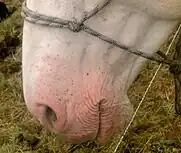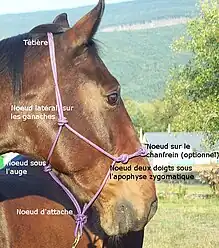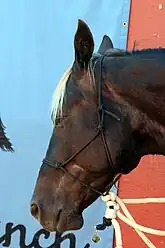Ethological halter
An ethological halter, sometimes called an American halter or a knotted halter, is a working halter for horses, generally made of cord. Invented in the United States by horse whisperers inspired by the vaquero bosal, it spread to Europe in the 2000s, with the wave of interest in natural horsemanship. The tool was adopted by well-known riders, in particular Michel Robert.
 American horse fitted with a green ethological halter, with a clearly visible lateral closing knot. | |
| Notable role | Horse tack |
|---|---|
Designed as a working halter adapted to western riding practices, it works by pressure points, with knots that press on innervated areas of the horse's head, and a thin section behind the ears. It enables you to work the horse, especially on the lead rope, in a finer way than with a flat halter, while preserving the horse's mouth. Significantly more economical than a conventional halter, the ethological halter is reputed to be less sturdy, and can become painful and dangerous if misused.
Name
Although this equipment is commonly referred to as an "licol éthologique" in France, its correct name would be "halter with knots ".[1] The original English name, though, is "rope halter".[2] In the US, this type of tool is also known as a "cowboy halter",[3] and in German as a "knotenhalfter".[4] It is also known as an American halter in French.[5]
Description
An ethological halter is a halter made of rope,[5] usually 6 to 8 mm diameter cord,[6] with three or more knots,[7] two of which connect the upright to the noseband.[6] These knots are designed to be placed on innervated areas of the horse's head,[6] at strategic points: on either side of the muzzle, under the trough, and under the zygomatic apophyses.[7] The noseband knot should be about two fingers below this bony ridge,[2][3] and the cord passing over the muzzle should be halfway between the eyes and nostrils.[3]
The halter is tightened with a side closing knot.[8][2] You can attach a lead rope to the attachment knot under the trough, and reins to the same point, or to either side of the noseband.[6] It's also possible to make your own, from rope.[9][10] The diameter of the rope, or cord, defines the potential severity of the halter on the horse.[11]
The simple appearance of the ethological halter may lead to the mistaken belief that it is a gentle tool.[7] In fact, the pressure points it applies to bony areas can have a very powerful effect on the horse, due to the fineness of the rope (the finer it is, the greater the pressure exerted).[7] Ethological halters made from braided cotton are now very popular, due to their low cost (around 20 euros in 2011[4]) and ease of adjustment, enabling several horses to be worked with the same equipment.[12] It's light for the horse to wear and allows precision work.[8] On the other hand, it sometimes lacks the strength and durability of a flat leather halter.[12] While they cannot be repaired, unlike leather halters, they do have the advantage of being maintenance-free.[3] Testimonials about halters breaking are rare,[2][13] but it is advisable to avoid very inexpensive halters, some of which have badly placed knots or can move around on the horse's head, impairing the quality of the work done, and can prove dangerous.[13]
According to the reference work Equine Science, this type of halter tends to get dirty easily, even rotting over time.[12] According to the French periodical Cheval Magazine, users find them easy to maintain.[8]
History
The principle of the ethological halter seems to have been discovered by American Horse Whisperer Tom Dorrance.[1] The American veterinarian Robert M. Miller believes that its use in the USA stems from the bosal hackamore of the Vaqueros, which has been adopted by almost all practitioners of natural horsemanship in the form of a rope halter with knots.[14] According to Cynthia McFarland, American cowboys were the first to discover and make a rope halter.[3]
The use of this equipment spread from the United States to France in the early 2000s,[6] as well as to Germany,[4] accompanying the development of ethological equitation. French rider Michel Robert is a pioneer in the world of show jumping.[15] Equestrian equipment manufacturers have adapted to demand. Many now offer this type of halter for sale, with a wide choice of models, colors and materials, and knots that can be placed in different ways.[15] In the United States, the marketing of an ethological halter supposed to make horses softer, under the name of be-nice, has sparked debate.[15]
Uses
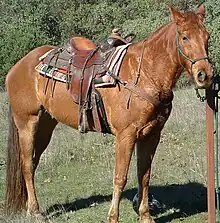
The ethological halter can replace the bit when working on foot, on a lead rope or mounted. Codes need to be defined or transposed if the horse has already been trained with a bit.[16] This tool is generally used in western riding, natural horsemanship, lunging and, in general, for all types of work with horses in hand.[6] In the US the halter is commonly used to ride foals to avoid the use of a bit, with reins attached to a metal ring.[13] In this context, the ethological halter is recommended for training young horses, to give them greater control.[11]
With an ethological halter, the horse is encouraged (or forced) to yield to the pressure points distributed over strategic areas of his head.[8] If he resists the halter, he inflicts the pressure of the rope behind his ears on himself, thus causing pain.[8] Any parasitic action is to be avoided,[8] as the rider's pulling of the halter forces the horse to react to the pressure. The "lightness" of the ethological halter is only evident if the user uses it wisely and knows its settings, hence the many abuses.[17] There is some controversy in the equestrian world as to which type of halter is preferable. The ethological rope halter is said to empower the horse without much effort on the part of the trainer, as the pressure exerted is much greater than with a flat halter.[18]
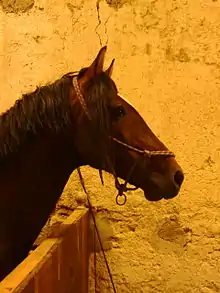
Michel Robert uses an ethological halter for both lunging and saddling,[15] believing that it enables him to work horses that are in pain from the bit.[19] Italy's Luca Moneta also works with these tools.[19] On the other hand, Catherine Sell, creator of foot exercises she calls equility, prefers the flat halter.[20] The Nevzorov High School in Russia is also against the use of the ethological halter.[21]
Dangers
Ethological halters can be dangerous depending on how they are used. Some equine osteopathies have treated horses with pain in the headpiece area, due to the halter's fine cord, which passes over a point where the cranial nerves converge. In foals and young horses, this can lead to bone deformation.[7] If badly adjusted, the halter can shear the horse's skin.[8] It is particularly inadvisable to tie a horse with an ethological halter, as the horse could inflict very serious injuries on itself if it struggles.[22] Some horses are sensitive to the passage of knots and cannot tolerate this tool.[23]
Generally speaking, as Carlos Henriques Pereira points out, the field of ethological equitation, which promotes the use of specific equipment, is plagued by "charlatans and other gurus".[24]
See also
References
- J. Jack Braunschweig (2016). Psychologie équine et l’équitation Western: Éducation / Entrainement / Pleasure / Reining / Trail / Cutting / Working Cow, etc (in French). Atramenta. p. 37. ISBN 9522737925..
- Cherry Hill (2012). Trailering Your Horse: A Visual Guide to Safe Training and Traveling. Horsekeeping Skills Library. Storey Publishing. p. 61. ISBN 1612122434..
- McFarland 2013, p. 8.
- Tillisch 2011, p. 14.
- Laurence Grard Guénard (2008). Les fondamentaux de l'attelage: Galops 1 à 7 (in French). Editions Amphora. p. 66. ISBN 2851807382..
- Percheron 2017, p. 53.
- Lattach 2005, p. 29.
- Percheron 2017, p. 54.
- Laura Pellet – Fabriquer son propre licol éthologique on YouTube.
- Diane Longanecker (2009). Halter-Tying Success, Second Edition: A Step-by-Step Guide for Making Hand-Tied Rope Halters for Horses. Laura Gabbard (2 ed.). Horse Owner Success Books. ISBN 0963532073..
- McFarland 2013, p. 10.
- .Parker, Rick (2012). "Halters". In Cengage Learning (ed.). Equine Science (4 ed.). p. 490. ISBN 111113877X.
- McFarland 2013, p. 11.
- Emily Esterson (2014). The Ultimate Book of Horse Bits: What They Are, What They Do, and How They Work. Skyhorse Publishing, Inc. p. 221. ISBN 1629140910..
- Lattach 2005, p. 26.
- Collectif (2001). La Grande Encyclopédie Fleurus Cheval (in French). Fleurus. p. 217. ISBN 9782215051756..
- Lesté-Lasserre 2013, p. 50-51.
- Nathan Bowers (2010). 4-H Guide to Training Horses. Katie Bowers Reiff. MBI Publishing Company. p. 48. ISBN 1616732202..
- Lattach 2005, p. 27.
- Antoinette Delylle (2013). Ce que les chevaux ont à nous dire. Éditions du Rocher. ISBN 2268083527..
- Nevzorov Haute École, ed. (2009). "Interdictum". Nevzorov Haute École Équine Anthology (in French). 1: 21..
- Lattach 2005, p. 33.
- Tillisch 2011, p. 15.
- Carlos Pereira (2011). Dressage et Éthologie : Le carré de votre réussite, Les quatre fondamentaux d'une approche de l'art équestre (in French). Amphora. p. 45. ISBN 2851808028..
Bibliography
- Lattach, Fanny (2005). "Sans mors, sans fers, sans arçon... On enlève tout ?". Chebal Magazine (520): 24–33. ISSN 0245-3614.
- Lesté-Lasserre, Christa (2013). "Sans mors, pas sans douleur". Cheval Magazine (495): 50–51. ISSN 0245-3614.
- McFarland, Cynthia (2013). Western horseman's guide to tack & equipment. Rowman & Littlefield. ISBN 0762795980.
- Percheron, Aurélie (2017). "Le licol éthologique, un outil de travail". Cheval Magazine (544): 53–54. ISSN 0245-3614.
- Tillisch, Karin (2011). "Knotenhalfter". Kreative Bodenarbeit: Basisübungen und Erziehung an der Hand (in German). Cadmus Publishing. ISBN 3840460530.
